|
Week 7: September 12-18, 2012 |
Welcome
to the McGill Bird Observatory weekly report.
Click here for a complete listing of our archives.
Comments or
questions are welcome at "mbo AT migrationresearch.org".
|
PICTURE
OF THE WEEK: |
|
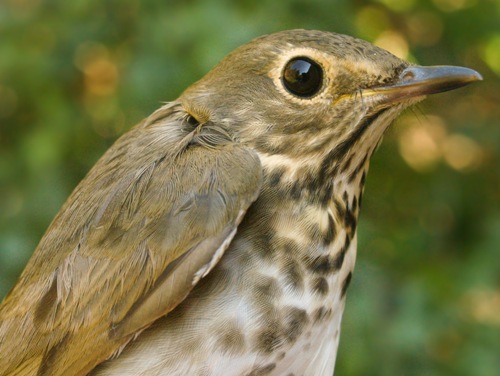
Where are all the Swainson's Thrushes coming from? This week alone we banded
nearly twice as many of them as in any of our previous 7 full fall seasons!
(Photo by Simon Duval)
-
|
|
|
THIS WEEK |
THIS FALL |
2012 TOTAL |
SITE TOTAL |
|
# birds (and species) banded |
404 (49) |
1757 (72) |
3022 (83) |
38773 (108) |
|
# birds (and species) repeat |
89 (19) |
465 (32) |
803 (46) |
7216 (69) |
|
# birds (and species) return |
15 (7) |
58 (20) |
197 (27) |
1158 (38) |
|
# species observed |
84 |
127 |
160 |
207 |
|
# net hours |
544.0 |
3807.8 |
7067.6 |
66166.7 |
|
# birds banded / 100 net hours |
74.3 |
46.1 |
42.8 |
58.6 |
|
|
Note: table does not include nocturnal banding (owls) |
|
Banders-in-charge: Simon Duval, Gay Gruner
Assistants: Richard Beauchamp, Nicolas Bernier, Marc Boisvert, Cindy Bouchard, David Davey, Rui de Jesus, Leah den Besten, Amanda Droghini, Réjean Duval, Tammy Elliot, Liette Fortier, Louise Gagné, Jo-Annie Gagnon, Monique Groulx, Alison Hackney, Myriam Haineault, Lisa Keelty, Shelley Kirk, Joane Lafontaine, Marie-Pier Laplante, Francine Marcoux, Betsy McFarlane, Ana Morales, Chris Murphy, Benoit Piquette, Yves Poirier, Geneviève Potvin, Catherine Russell, Marilou Skelling, Rodger and Elise Titman, Carine Touma, Jay Vandergaast
Notes: Last week's upsurge in migration continued throughout this week. We banded between 28 and 86 individuals daily, topping 50 birds every day except Saturday and Tuesday. The total of 404 was the second-highest ever for week 7, and the season total of 1757 nearly matches the pace of our record-setting 2010 season when we had 1779 by this point - although notably comprising only 64 species, compared to 72 already this fall. This year's robust counts continue to in part reflect our extraordinary run of dry weather, with a nearly full 544 net hours of coverage again this week. Perhaps the most remarkable statistic though is that only halfway through the season, we have already had more returns than in any previous complete fall season - an interesting pattern that we plan to explore in more detail as part of our annual report.
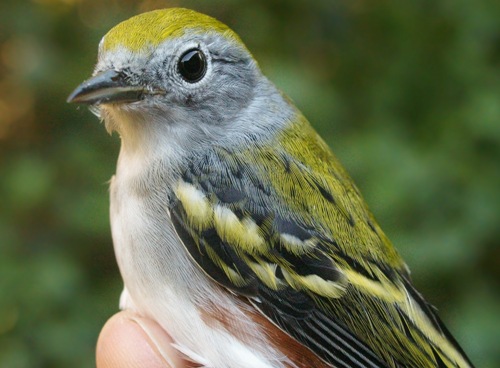
A couple of MBO's less abundant warblers - Chestnut-sided Warbler (above) with 23 banded to this point in the season, and Bay-breasted Warbler (below), with just 5 individuals to date.
(Photos by
Simon Duval)
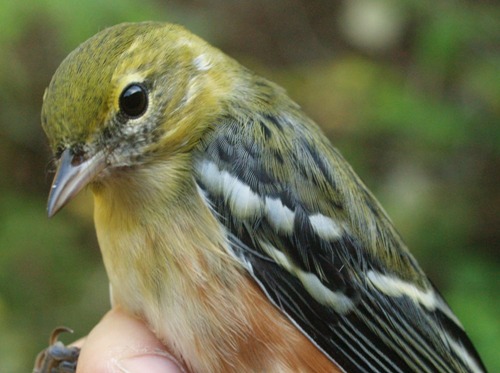
|
Only one new species for the year was observed at this week, but it was a notable one - Northern Saw-whet Owl. Our owl migration monitoring program does not officially begin until September 26, but observatories to our north, including l'Observatoire d'Oiseaux de Tadoussac, are already reporting substantial movements, so it appears the owls have an early start on migration this year. On Sunday morning, we observed one saw-whet during a net round, and caught a second one in D3 - the first time we have banded one as part of our songbird monitoring program outside of our owl banding season. Other species observed for the first time this fall were Blue-headed Vireo, Brown Creeper, Winter Wren, Gray-cheeked Thrush, and Hermit Thrush, bringing the season total to 127, the highest ever count a the mid-point of fall. In addition to the saw-whet, we banded another six species for the first time this fall: Blue-headed Vireo, Red-breasted Nuthatch, Brown Creeper, Gray-cheeked Thrush, Hermit Thrush, and White-crowned Sparrow. Also of note, we had our first White-throated Sparrow return of the season.
This week’s top 10 [last week's rank in brackets]
# individuals banded |
mean # individuals observed daily |
1. Swainson's Thrush (66) [2] |
1. Blue Jay (54) [6] |
2. Magnolia Warbler (59) [1] |
2. Canada Goose (46) [2] |
3. White-throated Sparrow (53) [-] |
3. White-throated Sparrow (42) [7] |
4. Common Yellowthroat (18) [-] |
4. American Goldfinch (26) [3] |
5. Black-throated Green Warbler (15) [-] |
5. Common Grackle (21) [1] |
6. Nashville Warbler (13) [9] |
6. American Crow (21) [4] |
6. Song Sparrow (13) [5] |
7. Black-capped Chickadee (20) [5] |
8. Gray Catbird (12) [9] |
8. Swainson's Thrush (16) [-] |
8. Blackpoll Warbler (12) [3] |
9. American Robin (16) [-] |
8. American Goldfinch (12) [7]
|
10. Magnolia Warbler (12) [8] |
|
As previously noted, the impressive migration of Swainson's Thrushes went into overdrive this week - enough so that it vaulted them into top spot for the first time ever, just slightly ahead of Magnolia Warbler, which dominated week 7 in four of the past six years. Close behind in third place was White-throated Sparrow, rising to prominence around the same point in the season as usual. After dropping out of the top ten last week for the first time this season, we had a resurgence of Common Yellowthroats this week, landing them in fourth place and bringing the season total to 112 individuals, eclipsing the previous season record of 100 set in 2010. Rounding out the top five with an uncharacteristically concentrated movement was Black-throated Green Warbler, the 15 individuals marking a single-week record for the species. The remainder of the top ten features a mix of species from last week's list, all in similar numbers this week - Gray Catbird, Nashville and Blackpoll Warbler, Song Sparrow, and American Goldfinch. Dropping off from last week were three other warblers - Tennessee, Wilson's, and American Redstart. Redstart is still the third most abundant species for the season overall, behind only Song Sparrow and Magnolia Warbler, which this week overtook the lead with a cumulative total of 186 individuals to date.
After dominating the skies of MBO for most of the season, the Common Grackle flocks finally tapered off this week, and instead the Blue Jay flocks swelled from 18 to 120 daily, averaging 54 per day (nearly double the previous high at this time of year), enough to take over the top spot. Canada Goose remained the runner-up yet again, while the increase in White-throated Sparrows was reflected as strongly in observations as in the banding totals. Goldfinches and grackles both slipped down a bit this week to round out the top five, in turn bumping American Crow and Black-capped Chickadee each down a couple of spots too. Swainson's Thrush made a rare appearance in the top ten of species observed, as common this week as American Robins! Magnolia Warbler was the only warbler species abundant enough to crack this week's top ten species observed. Song Sparrow and Gray Catbird were displaced from last week's list.
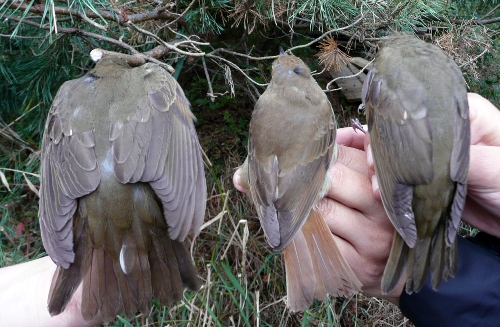
Although Swainson's Thrushes dominated the week, we also had some of their close relatives pay a visit. Can you recognize these three species from this angle? Answers at the end of this week's report.
(Photo by
Gay Gruner)
|
As always, the weeks have flown past (pardon the pun) and it's hard to believe that we are already past the midway point of the Fall Migration Monitoring Program. However, we expect that the increase in numbers we've seen over the past couple of weeks will only continue to build, given that weeks 8 through 11 traditionally represent the busiest time of year at MBO. But of course we can never be sure how migration will unfold ... we will have further news in next week's report.
|
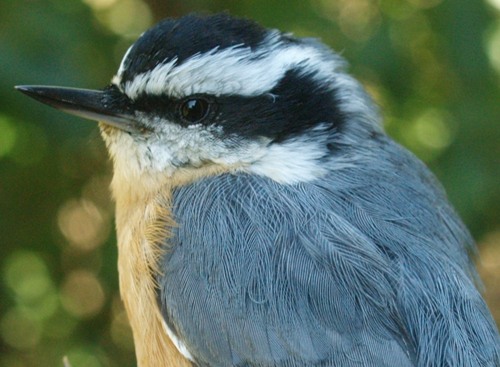
Although large flocks of Red-breasted Nuthatches have been swarming parts of southern Ontario already this fall, the invasion has so far been a bit more modest at MBO. While above average numbers have been seen, this male banded this week was the first one caught this fall.
(Photo by Simon Duval)
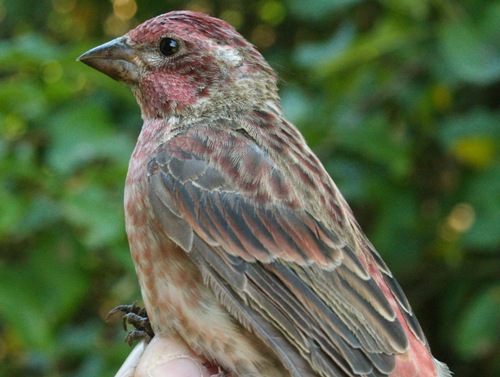
Seemingly moving in tandem with the Red-breasted Nuthatches are Purple Finches, although we have been banding more of them - 25 as of the end of this week, shattering the previous season record of 11. This second-year male can be easily aged by the stark contrast between his faded brown outer primaries and inner secondaries, compared to the replaced feathers in between.
(Photo by
Simon Duval)
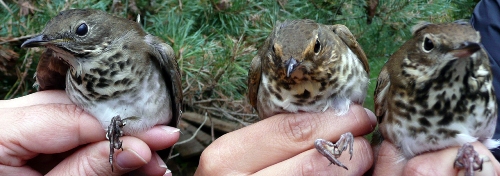
Here is a front view of the three thrushes - but did you notice that two of them have switched position compared to the previous photo? On the left in both photos is a Gray-cheeked Thrush; in the middle here and on the right in the previous photo is one of our many Swainson's Thrushes; on the right here and in the middle previously is the first Hermit Thrush of the season.
(Photo by
Gay Gruner)
|







